Understand fire safe valve standards like API 607 and API 6FA, and learn how certified ball valves protect flow systems under fire exposure.
Overview
Fire safe ball valves are engineered to maintain critical shutoff performance even when exposed to fire. In this guide, you’ll learn:
- What makes a ball valve “fire safe”
- Understanding API 607 Certification
- How fire safe testing is performed
- Why certification matters for safety and compliance
- How to select a certified fire safe ball valve
What Is a Fire Safe Ball Valve?
A fire safe valve is designed to prevent catastrophic leakage when exposed to high heat or open flame. These valves are built with special materials and backup seals to ensure they maintain shutoff capability during and after a fire.
Typical fire-safe designs include:
- Graphite packing or fire-resistant soft seats
- Secondary metal-to-metal sealing surfaces
- Anti-static devices
Understanding API 607: Fire Test for Soft-Seated Valves
API 607 is the primary standard governing the fire safety performance of soft-seated quarter-turn valves, including ball valves. It is issued by the American Petroleum Institute (API) and outlines the requirements a valve must meet to be considered fire safe.
What Does API 607 Cover?
- Applies to valves with soft seats, seals, and other non-metallic components
- Specifies how valves should perform when exposed to fire conditions
- Includes testing procedures for valve shutoff and pressure retention before, during, and after fire exposure
Fire Test Procedure
- The valve is closed and pressurized with gas or liquid.
- It is exposed to a direct flame for approximately 30 minutes at temperatures around 1400°F (760°C).
- Leakage is monitored during the burn and after cooling to verify continued containment.
- Valves must meet strict leakage limits to pass.
Why It Matters
Valves certified to API 607 help ensure system integrity in the event of a fire. They are often required in applications where flammable fluids are present, such as:
- Petrochemical processing
- Refineries
- Tank farms and loading stations
Using API 607-compliant ball valves minimizes risk and ensures adherence to safety and insurance standards.
How Fire Safe Valve Testing Works
To qualify as fire safe, valves must pass a rigorous fire exposure test. Here’s how it works:
- Valve is installed in a test rig and pressurized with gas or liquid.
- It is exposed to direct flame for a defined time (typically 30 minutes at approximately 1400°F / 760°C).
- Leakage is measured during and after the fire.
- Valve is cooled and retested to ensure continued shutoff function.
Why Fire Safe Certification Matters
- Reduces fire propagation in hazardous systems
- Meets insurance and regulatory standards (e.g. OSHA, EPA)
- Prevents secondary explosions or toxic release
- Validates performance under worst-case fire scenarios
Fire safe certified valves are often required in applications involving:
- Oil and gas
- Chemical plants
- Refineries
- Tank farms and loading stations
How to Select a Fire Safe Ball Valve
When specifying a fire safe valve, consider the following:
- Certifications: API 607, API 6FA, or ISO 10497
- Valve size and end connections: flanged, threaded, welded
- Seat and seal materials: PTFE, graphite, metal-seated
- Pressure rating: ANSI 150, 300, or 600
- Documentation: Third-party test reports and certifications
Download our Comprehensive Guide to Valves, Actuators & Controls or contact SVF for support.
Related Resources
- Complete Guide to Valve Leakage Classes (Class I–VI)
- How to Calculate CV for Globe, Gate, and Check Valves
- About Fire-Safe Design
Conclusion
In industries where fire risk is real, fire safe valves are not optional—they are essential. Selecting a certified fire safe ball valve can protect life, equipment, and the environment. Always verify API certification and testing data before installation.
Need certified fire safe valves? Explore SVF’s Ball Valve Product Line


